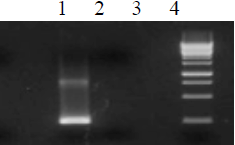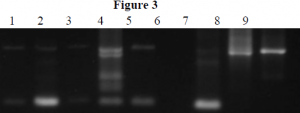Matthew Lelegren
Introduction
As described in the proposal, my goal was to further understand the mechanisms of mRNA processing of the chicken gene called Cyclooxygenase (COX)-2. There are many mechanisms by which mRNA molecules are modified in order to produce proteins that fulfill the needs of a given cell. The mechanism I chose to study was called alternative splicing, a process through which sequences are removed from the mRNA thereby altering the structure and function of the protein to be translated from its sequence. In brief summary splicing mechanisms, the cells possess machinery that recognize certain sequences, called splice sites, as a guide for determining which sequences to retain and which to remove. Previously, I had shown that in Chinese Hamster Ovary (CHO) cells the chicken COX-2 gene could produce two distinct mRNA molecules (Lane 1 of Figure 1). At the beginning of 2013, I sought to determine how human cell lines, namely human osteosarcoma (U2OS) cells and human lung adenocarcinoma (A549) cells, would splice the chicken COX-2 gene. I found that the same splicing event occurs in A549 and U2OS cells. We also learned more about how the chicken COX-2 mRNA is processed in U2OS cells. Herein, I report that mutation of splice sites alone is not sufficient to govern alternative splicing of the chicken COX-2 mRNA and propose, although without evidence, that signals from within the cell are additional requirements for splicing. 
Methodology
The methods used to study the alternative splicing of the chicken COX-2 gene were site directed mutagenesis and reverse transcription polymerase chain reaction (RT-PCR). The reagents and protocol for the both experiments were obtained from Life Technologies and were unmodified in our experiments.
Results
Figure 2 shows the results of the splicing of chicken COX-2 in A549 cells. The faintly detected upper bands in lane 1 indicate the presence of different products of alternative splicing. Lane 4 is a molecular weight marker to determine the weights of the products and lanes 2 and 3 show the negative control and a blank lane, respectively. Figure 3 shows the results from the splicing of chicken COX-2 and chicken COX-2 with a mutant splice site. The bands detected in lane 2 indicate the presence of different products of alternative splicing. The bands detected in lane 4 show a different pattern indicating that mutation of the splice site in deed has an effect on splicing. Lanes 7, 8 and 9 are positive controls to compare known splice variants to the ones obtained in this experiment. Lanes 1, 3, and 5 are negative controls containing background. 
Discussion
Upon the discovery that the chicken COX-2 gene could undergo splicing to produce distinct mRNA molecules in CHO cells, I investigated whether such would be the case in the human cell lines A549 and U2OS. Figures 2 and 3 both demonstrate that such is the case as described in the results section. Such results lead us to question whether the decision of whether to splice to one form or the other was governed by a recognition sequence in the mRNA or whether a signal from within the cell. I mutated the chicken COX-2 gene and as the results in lane 4 of figure 3 show determined that approximately 50% of the mRNA molecules were not spliced. It appears, therefore, that the sequence of the mRNA plays a role in determining whether a cell will splice the chicken mRNA. However, there must be other factors involved. In an effort to explore what other factors are involved, I treated U2OS cells with different conditions that would cause the cells to undergo stress. The intracellular signaling patterns of a cell change when a it undergoes stress. The hope was that one of these changes in intracellular signaling would alter the decision of how to splice the chicken COX-2 mRNA. I used three different conditions to stress the cells: UV light irradiation, alkaline media treatment, and a combination of the two. The results however were inconclusive and are therefore not included in this report.
Conclusion
These data suggest that cellular machinery in at least two types of human cell lines, namely A549 and U2OS, the chicken COX-2 mRNA can be processed in various manners. I have shown that the sequence of mRNA plays a part of the decision of which mRNA product. It is likely that another factor in the decision making process includes the intracellular signaling patterns.

